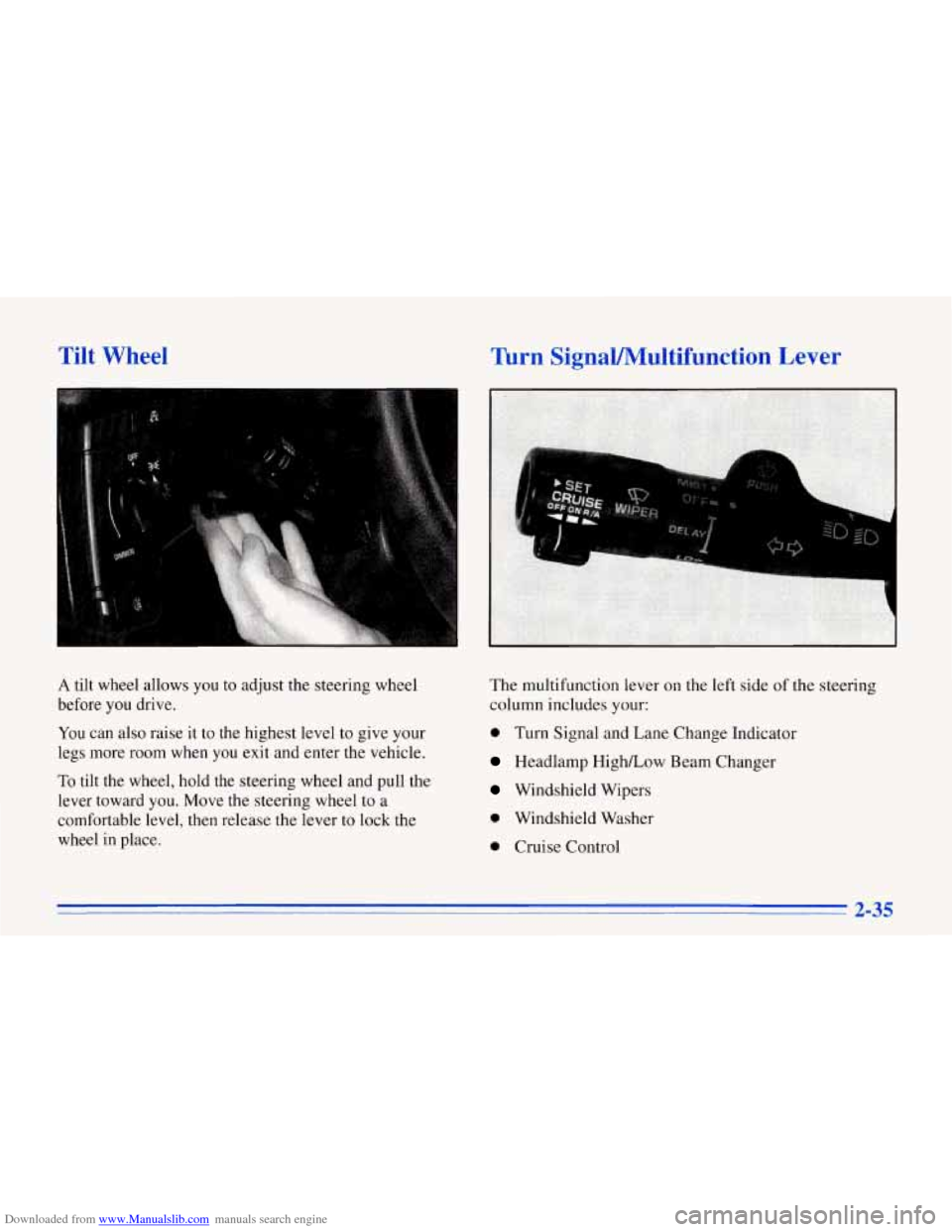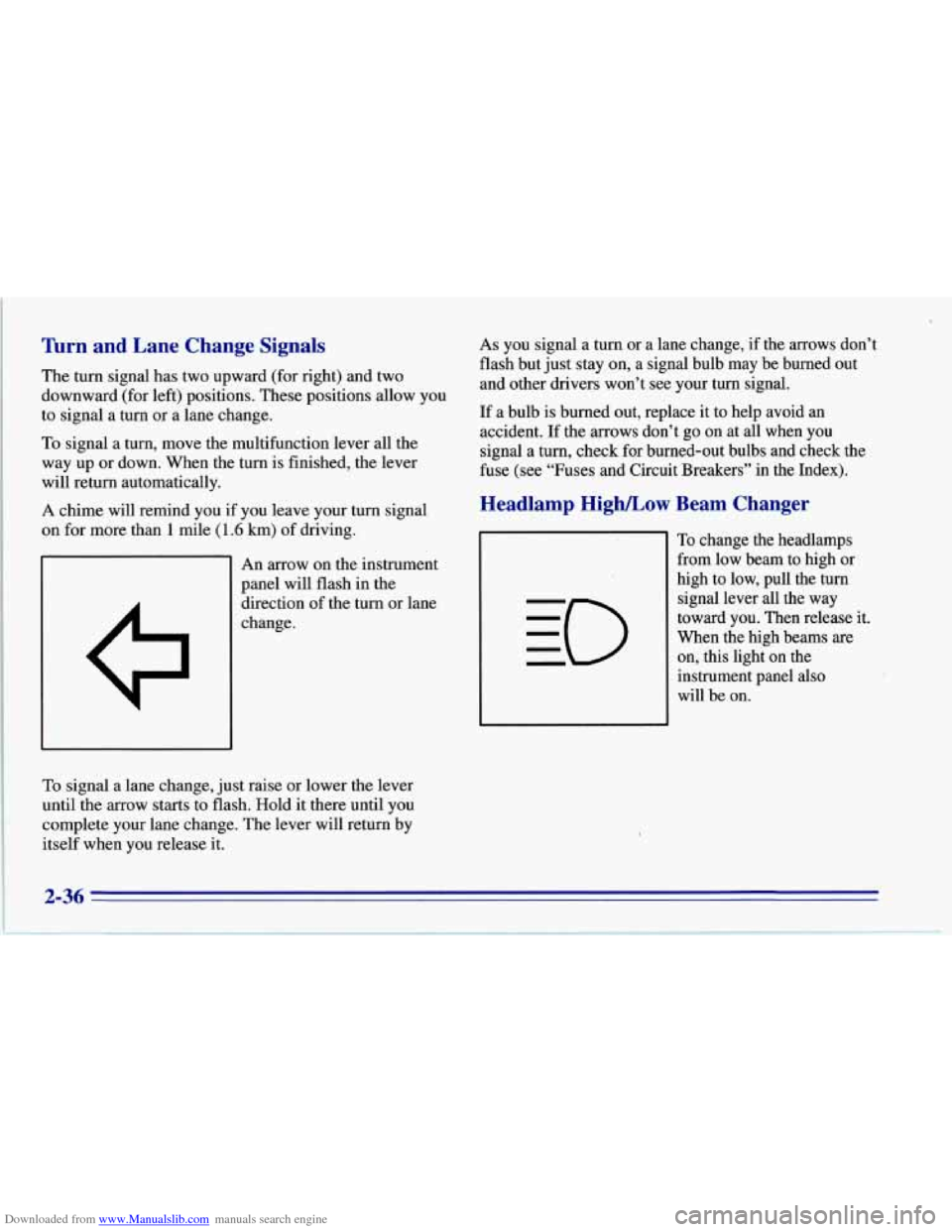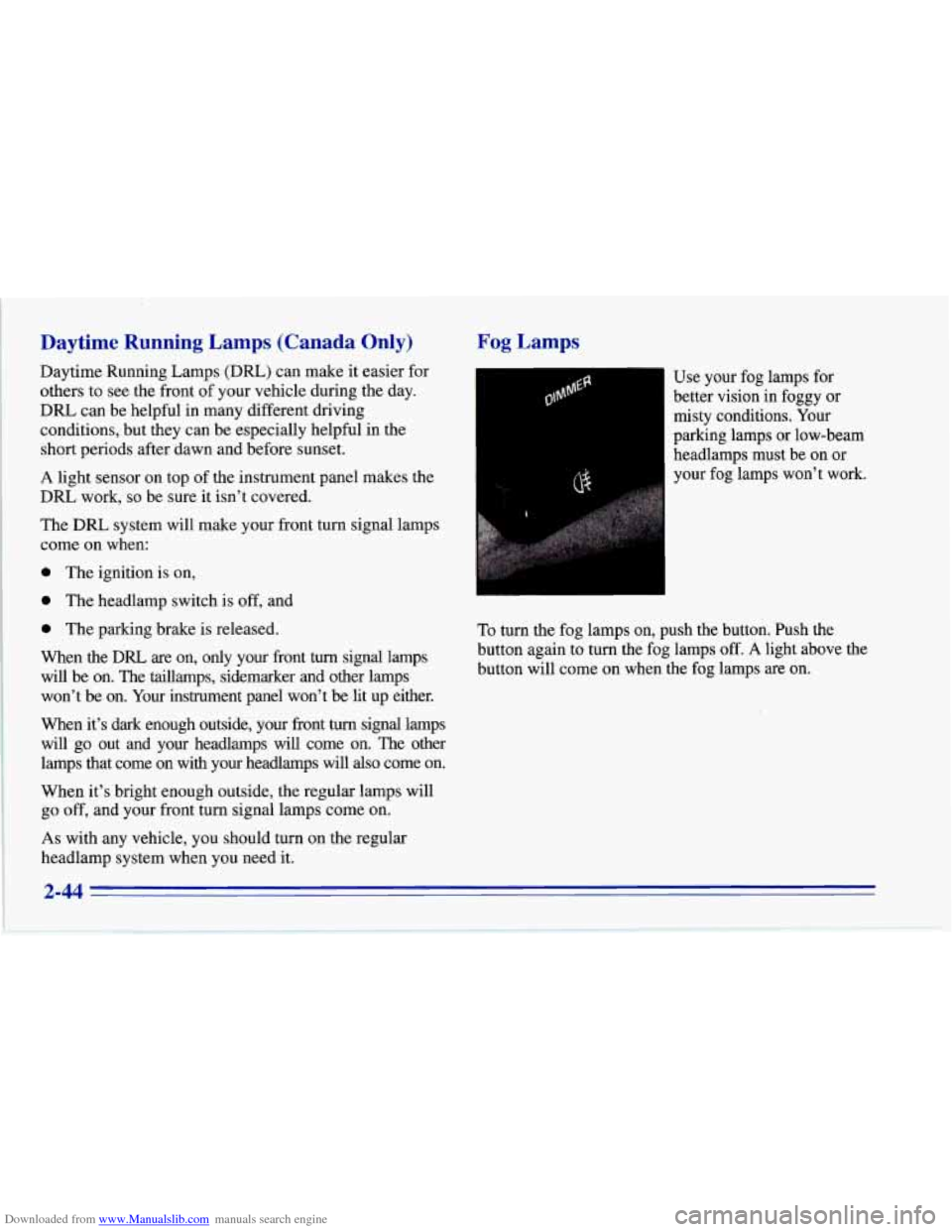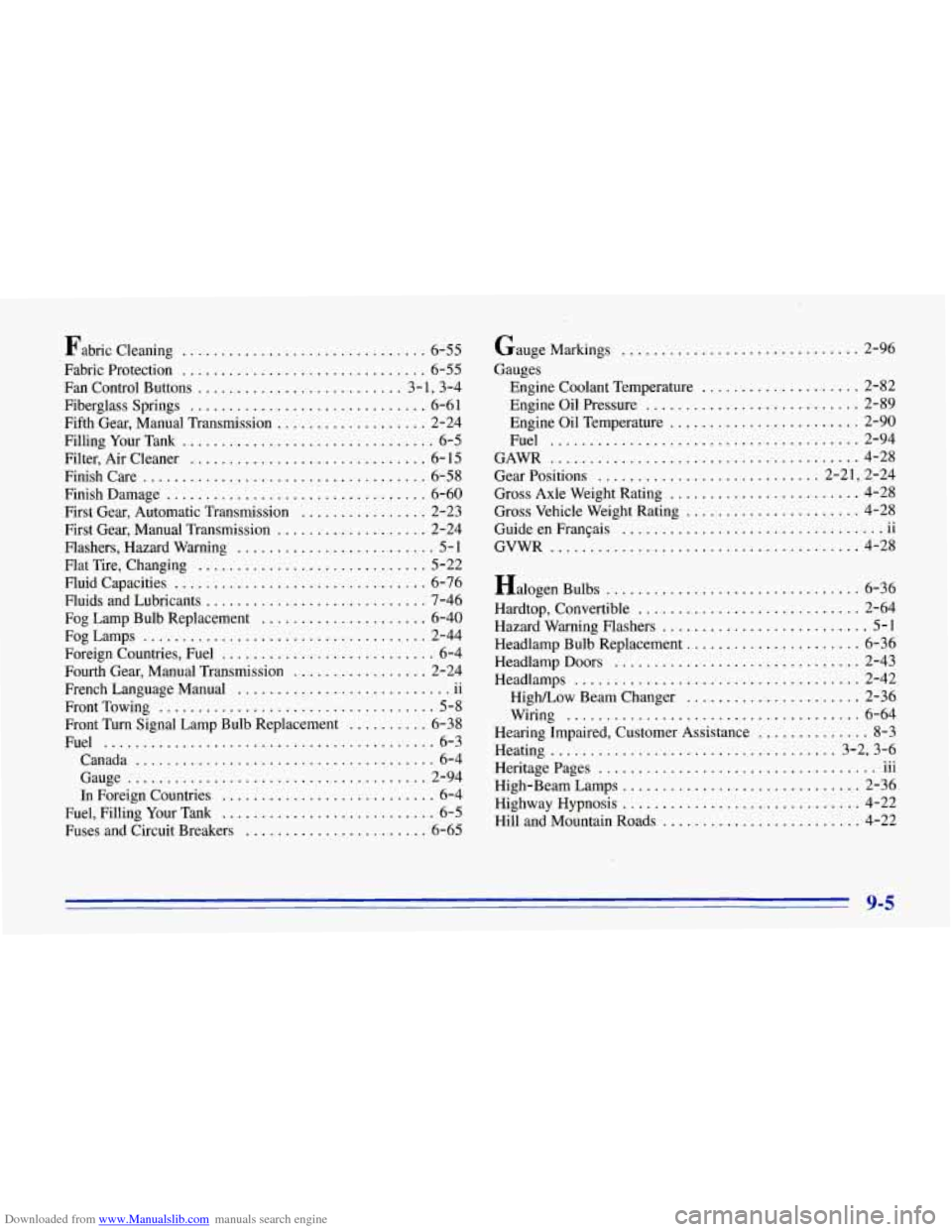1996 CHEVROLET CORVETTE low beam
[x] Cancel search: low beamPage 78 of 386

Downloaded from www.Manualslib.com manuals search engine Tilt Wheel
A tilt wheel allows you to adjust the steering wheel
before you drive.
You can also raise it to the highest level to give your
legs more
room when you exit and enter the vehicle,
To tilt the wheel, hold the steering wheel and pull the
lever toward you. Move the steering wheel to a
comfortable level, then release the lever to lock the
wheel in place.
Turn SignaYMultifunction Lever
The multifunction lever on the left side of the steering
column includes your:
0 Turn Signal and Lane Change Indicator
Headlamp HighLow Beam Changer
Windshield Wipers
0 Windshield Washer
0 Cruise Control
2-35
Page 79 of 386

Downloaded from www.Manualslib.com manuals search engine nrn and Lane Change Signals
The turn signal has two upward (for right) and two
downward (for left) positions. These positions allow you
to signal a turn or a lane change.
To signal a turn, move the multifunction lever all the
way up or down. When the turn is finished,
the lever
will return automatically.
A chime will remind you if you leave your turn signal
on for more than
1 mile (1.6 km) of driving.
An arrow on the instrument
panel will flash in the
direction of the turn or lane
change.
To signal a lane change, just raise or lower the lever
until the
arrow starts to flash. Hold it there until you
complete your lane change. The lever will return by
itself when you release it.
As you signal a turn or a lane change, if the arrows don’t
flash but just stay on, a signal bulb may be burned out
and other drivers won’t see your turn signal.
If a bulb is burned out, replace it to help avoid an
accident.
If the arrows don’t go on at all when you
signal a turn, check for burned-out bulbs and check the
fuse (see “Fuses and Circuit Breakers” in the Index).
Headlamp High/Low Beam Changer
To change the headlamps
from low beam to high or
high to low, pull the turn
signal lever all the way
toward you. Then release it.
When the high beams
are
on, this light on the
instrument panel also
will be on.
Page 87 of 386

Downloaded from www.Manualslib.com manuals search engine Daytime Running Lamps (Canada Only)
Daytime Running Lamps (Dm) can make it easier for
others to see the front of your vehicle during the day.
DRL can be helpful in many different driving
conditions, but they can be especially helpful in the
short periods after dawn and before sunset.
A light sensor on top of the instrument panel makes the
DRL work,
so be sure it isn’t covered.
The DlU system will make your front turn signal lamps
come on when:
0 The ignition is on,
0 The headlamp switch is off, and
0 The parking brake is released.
When
the DRL are on, only your front turn signal lamps
will be on. The taillamps, sidemarker and other lamps won’t be on. Your instrument panel won’t
be lit up either.
When it’s dark enough outside, your front
turn signal lamps
will go out and your headlamps will come on. The other
lamps that come on with your headlamps will
also come on.
When it’s bright enough outside, the regular lamps will
go
off, and your front turn signal lamps come on.
As with any vehicle, you should turn on the regular
headlamp system when you need it.
Fog Lamps
I-1 Use your fog lamps for
better vision in foggy or
misty conditions. Your
parking lamps or low-beam
headlamps must be on or
your fog lamps won’t work.
To turn the fog lamps on, push the button. Push the
button again to turn the fog lamps
off. A light above the
button will come on when the fog lamps are on.
2-44
Page 177 of 386

Downloaded from www.Manualslib.com manuals search engine You can be temporarily blinded by approaching
headlamps.
It can take a second or two, or even several
seconds, for your
eyes to readjust to the dark. When you
are faced with severe glare (as from a driver who
doesn’t lower the high beams, or a vehicle with
misaimed headlamps), slow down a little. Avoid staring
directly into the approaching headlamps.
Keep your windshield and all the glass on your vehicle
clean
-- inside and out. Glare at night is made much
worse by dirt on the glass. Even the inside of the glass
can build up a film caused by dust. Dirty glass makes
lights dazzle and flash more than clean glass would,
making the pupils of your eyes contract repeatedly.
Remember that your headlamps light up far less of a
roadway when you are in a turn or curve. Keep your
eyes moving; that way, it’s easier to pick out dimly
lighted objects. Just as your headlamps should be
checked regularly for proper aim,
so should your eyes
be examined regularly. Some drivers suffer from night
blindness
-- the inability to see in dim light -- and
aren’t even aware of it.
Driving in Rain and on Wet Roads
Rain and wet roads can mean driving trouble. On a wet
road, you can’t stop, accelerate or turn as well because
your tire-to-road traction isn’t as good as on dry roads.
And, if your tires don’t have much tread left, you’ll get
even less traction. It’s always wise to go slower and be
cautious if rain starts to fall while you are driving. The
surface may get wet suddenly when your reflexes are
tuned for driving on
dry pavement.
4-16
Page 179 of 386

Downloaded from www.Manualslib.com manuals search engine I . Hydroplaning
Hydroplaning is dangerous. So much water can build up
under your tires that they can actually ride on the water.
This can happen if the road is wet enough and you’re
going fast enough. When your vehicle is hydroplaning,
it has little or no contact with the road.
Hydroplaning doesn’t happen often. But it can if your
tires haven’t much tread or if the pressure in one or
more is low. It can happen if a lot of water is standing on
the road. If you can see reflections from trees, telephone
poles or other vehicles, and raindrops “dimple” the
water’s surface, there could be hydroplaning.
Hydroplaning usually happens at higher speeds. There
just isn’t a hard and fast rule about hydroplaning. The
best advice is to slow down when it is raining.
Driving Through Deep Standing Water
NOTICE:
If you drive too quickly through deep puddles or
standing water, water can come in through your engine’s air intake and badly damage your
engine. Never drive through water that is slightly
lower than the underbody
of your vehicle. If you
can’t avoid deep puddles
or standing water, drive
through them very slowly.
Some Other Rainy Weather Tips
a Turn on your low-beam headlamps -- not just
your parking lamps
-- to help make you more
visible to others.
a
e
Besides slowing down, allow some extra following
distance. And be especially careful when you pass
another vehicle. Allow yourself more clear room
ahead, and be prepared to have your view restricted
by road spray.
Have good tires with proper tread depth.
(See “Tires” in the Index.)
4-18
a
Page 378 of 386

Downloaded from www.Manualslib.com manuals search engine Fabric Cleaning ............................... 6-55
Fabric Protection
............................... 6-55
Fan Control Buttons
.......................... 3.1. 3.4
Fiberglass Springs
.............................. 6-6 1
Fifth Gear. Manual Transmission ................... 2-24
Filling Your Tank
................................ 6-5
Filter. Air Cleaner .............................. 6- 15
Finish Care .................................... 6-58
FinishDamage
................................. 6-60
First Gear, Automatic Transmission
................ 2-23
First Gear, Manual Transmission
................... 2-24
Flashers, Hazard Warning
......................... 5-1
Flat Tire. Changing
............................. 5-22
Fluid Capacities
................................ 6-76
Fluids and Lubricants
............................ 7-46
Fog Lamp Bulb Replacement
..................... 6-40
FogLamps
.................................... 2-44
Foreign Countries, Fuel
........................... 6-4
Fourth Gear, Manual Transmission
................. 2-24
French Language Manual
11
FrontTowing ................................... 5-8
Front Turn Signal Lamp Bulb Replacement .......... 6-38
Fuel
.......................................... 6-3
Canada
...................................... 6-4
Gauge
....................................... 2-94
In Foreign Countries
........................... 6-4
Fuel, Filling Your Tank
........................... 6-5
Fuses and Circuit Breakers
....................... 6-65
.. ...........................
GaugeMarhngs .............................. 2-96
Gauges Engine Coolant Temperature
.................... 2-82
Engine Oil Pressure
........................... 2-89
Engine Oil Temperature
........................ 2-90
Fuel
....................................... 2-94
Gear Positions
............................ 2-21, 2-24
Gross Axle Weight Rating
........................ 4-28
Gross Vehicle Weight Rating
...................... 4-28
Guide en FranGais
11
GAWR ....................................... 4-28
.. .................................
GVWR ..................................... 4-28
Halogen Bulbs
................................ 6-36
Hardtop. Convertible
............................ 2-64
Hazard Warning Flashers
.......................... 5-1
Headlamp Bulb Replacement
...................... 6-36
Headlamp Doors
............................... 2-43
HighLow Beam Changer
...................... 2-36
Wiring
..................................... 6-64
Hearing Impaired, Customer Assistance
.............. 8-3
Headlamps
.................................... 2-42
Heating
.................................... 3-2, 3-6
Heritage Pages .... 111 ...................................
High-Beam Lamps .............................. 2-36
Highway Hypnosis
.............................. 4-22
Hill and Mountain Roads
......................... 4-22
9-5